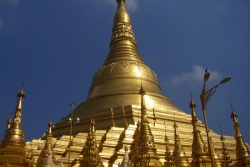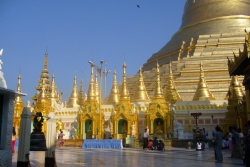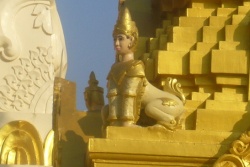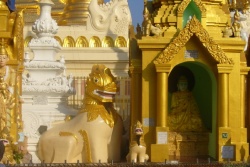The Famous Shwedagon Pagoda by David Maurice
<poem> ( First published in 'The Light of Dhamma', Vol.1, No. 1, Union of Burma Buddha Sasana Council, Rangoon, 1952)
The first Englishman ever to visit Burma was Ralph Fitch, who in the late fifteen hundreds sailed from the Thames in " the talle shippe "Tyger ", the same vessel mentioned by Shakespeare's witches in " Macbeth ". For the "Tyger" was indeed wrecked on its voyage to Aleppo and his good Kamma saved Ralph Fitch and eventually brought him home, safe and sound after many adventures including his short but happy sojourn in Burma.
Ralph Fitch found in Rangoon a cultured civilization in which commerce and the arts flourished, and the cleanness and sweetness of all he saw inspired him to write most enthusiastically - so much so that his story, published in Hakluyt's "Voyages" captured the imagination of all Europe.
He wrote of the mighty Shwedagon Pagoda; "It is the fairest place, as I suppose, that doe bee in all the worlde". Certainly the great Shwedagon is the oldest and mightiest of Buddhist fanes, and draws pilgrims from near and far to worship at its sacred base and to remember the Great Teachings of the Buddha as they repeat; "Anicca, Dukkha, Anatta " All is Impermanence, a source of discontent, with out any unchanging soul or ego ".
The ancient stories tell of the trading mission to India of two brothers, Burmese merchants, Tapussa and Bhallika by name, more than 2500 years ago, and of how they met the Buddha just after He had attained his long-sought Enlightenment, and obtained from Him eight hairs of His head to be enshrined in their native towN of Okkala, the present day Rangoon.
On their return, after many difficulties and dangers, the brothers met with a royal welcome and the Hairs of the Buddha were enshrined in a Golden Pagoda.
Through the ages this pagoda, the Shwedagon, has been added to until in 1774 it was raised to its present height of 326 ft. by Shin ByU Shin, King of Ava. Since the Shwedagon is on a hill overlooking Rangoon, it has a commanding position and dominates the landscape. Rising from the summit of the hill which has been levelled to form a plat form about 900 ft. long and 700 ft. wide the Pagoda is surrounded by tazaungs (shelters) which have some of the finest woodcraft and mosaic work existing in the world today. These tazaungs may have as many as five, seven or nine storied roofs some culminating in a spire and hti (umbrella). There are also almost innumerable figures of the Buddha of brass or of alabaster.
The Wonder Of The World
If the world has but seven wonders, then Shwedagon is not the least of them and there are many even among the non-Buddhists who come from the ends of the earth to see the beauty and romance of almost-fairy architecture, though there are those who, objecting to the Eastern injunction (given also to Moses) : "Take off thy shoes, for thou art upon Holy Ground", do not enter when they find that it is necessary to remove one's footwear. This prejudice is now happily dying out.
Many distinguished visitors in recent times have expressed their awe and reverence and have used that very phrase one of the wonders of the world ". With all the reverence and all the wonder inspired by this mighty symbol, one gets also the atmosphere of quiet happiness and tranquil joy that is so peculiarly Buddhist. A few of the many entries in the Visitors' Book show this.
" My visit to the Shwedagon Pagoda this morning is the fulfillment of a long-cherished ambition. Ever since I first heard of the Pagoda many years ago, as one of the world's supreme art treasures, I have looked forward to the day when its beauty and interest would change from a dream to a reality. Thanks to the kindness and courtesy of the Trustees of the Pagoda my dream has now come true. The Pagoda, in all its grace and dignity, has witnessed many dramatic events in Burma's long and illustrious history. I am happy to think that it will so soon witness the achievement by Burma of complete national independence, and the beginning of a new and glorious chapter in the career of a great people. May Britain and Burma always walk together as friends and equals."(7th September 1947; Lord LISTOWEL)
"The members of the United Kingdom Defence Mission to Burma were shown round the Pagoda on 24th August 1947. We have looked forward since our arrival in Burma to paving this visit not only because the Pagoda is, as a work of art, one of the wonders of the world, but also because of its particular significance as a symbol of Burmese unity.
The peoples of Great Britain and Burma will find mutual understanding easier to achieve if they can share together the appreciation of the world's treasures. We have felt this morning particularly, understanding of the aspirations and ideals of a united and independent Burma.( 24th August 1947; JOHN FREEMAN, Parliamentary Under Secretary of State,War Office. )
"I have been told of the Shwedagon Pagoda. I have read of the Shwedagon Pagoda. Now I have seen the Shwedagon Pagoda, and that is the best of all.
I am deeply grateful to the Trustees of the Pagoda for their kind welcome to me and my wife and members of my staff.
I regard it as a good omen that one of my first acts after my arrival in Rangoon as the High Commissioner of the United Kingdom has been to visit this wonderful shrine." (1st December 1947 JAMES BOWKER.)
"The dignity and splendour of what I have seen this evening I find difficult to express in words. What is even more striking is the atmosphere of peace and tranquillity. A visit to such surroundings is an inspiration and a source of spiritual strength and sustenance. My visit will remain one of the most cherished memories of my life. "(6th January 1948; ARTHUR HENDERSON, Secretary of State.)
Fire, earthquakes, the ravages of time and the inclemencies of the weather and, during the last war, British and Japanese bombs, have menaced the Shwedagon but still it gleams majestically towards the sky and Ralph Fitch's words are still as true: "It is, as I suppose, the fairest place that doe bee in all the Worlde."
Source



